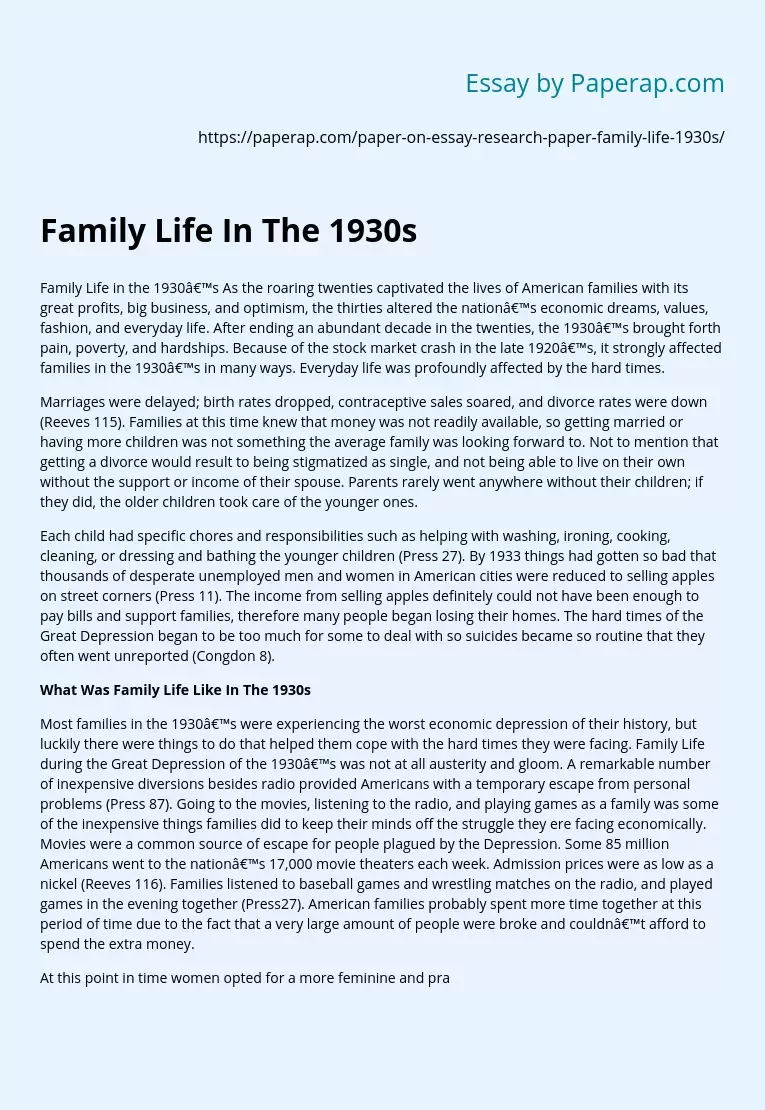Family Life In The 1930s
Family Life in the 1930’s As the roaring twenties captivated the lives of American families with its great profits, big business, and optimism, the thirties altered the nation’s economic dreams, values, fashion, and everyday life. After ending an abundant decade in the twenties, the 1930’s brought forth pain, poverty, and hardships. Because of the stock market crash in the late 1920’s, it strongly affected families in the 1930’s in many ways. Everyday life was profoundly affected by the hard times.
Marriages were delayed; birth rates dropped, contraceptive sales soared, and divorce rates were down (Reeves 115). Families at this time knew that money was not readily available, so getting married or having more children was not something the average family was looking forward to. Not to mention that getting a divorce would result to being stigmatized as single, and not being able to live on their own without the support or income of their spouse. Parents rarely went anywhere without their children; if they did, the older children took care of the younger ones.
Each child had specific chores and responsibilities such as helping with washing, ironing, cooking, cleaning, or dressing and bathing the younger children (Press 27). By 1933 things had gotten so bad that thousands of desperate unemployed men and women in American cities were reduced to selling apples on street corners (Press 11). The income from selling apples definitely could not have been enough to pay bills and support families, therefore many people began losing their homes. The hard times of the Great Depression began to be too much for some to deal with so suicides became so routine that they often went unreported (Congdon 8).
What Was Family Life Like In The 1930s
Most families in the 1930’s were experiencing the worst economic depression of their history, but luckily there were things to do that helped them cope with the hard times they were facing. Family Life during the Great Depression of the 1930’s was not at all austerity and gloom. A remarkable number of inexpensive diversions besides radio provided Americans with a temporary escape from personal problems (Press 87). Going to the movies, listening to the radio, and playing games as a family was some of the inexpensive things families did to keep their minds off the struggle they ere facing economically. Movies were a common source of escape for people plagued by the Depression. Some 85 million Americans went to the nation’s 17,000 movie theaters each week. Admission prices were as low as a nickel (Reeves 116). Families listened to baseball games and wrestling matches on the radio, and played games in the evening together (Press27). American families probably spent more time together at this period of time due to the fact that a very large amount of people were broke and couldn’t afford to spend the extra money.
At this point in time women opted for a more feminine and practical image than in the days of the flapper. Skirt length fell well below the knee, busts and waists reappeared, and hair styles became softer and more graceful (Reeves 118). Women often smoked cigarettes, drank, and gambled with men in public. Women, for the first time, wore slacks, revealed bathing suits, and participated in sports such as softball, roller skating, and bicycling (Reeves 115-116). These trends showed that women were ready for a change, not only in fashion, but in everyday life in the 1930’s.
In the first one hundred days of Franklin D. Roosevelt’s presidency one out of every three wage and salary earners- 12. 5 million men and women- were out of a job. Many American children had not had milk in months; in New York it was estimated that at least a fifth of the children in public schools were suffering from serious malnutrition (Simon 14). Although Roosevelt’s presidency was off to a bad start, it did not stop him from quickly trying to develop programs to help the people in America financially.
F. D. R’s decisive legislation would be a New Deal for America’s forgotten working men and women. It was sparked by the three R’s: Relief, Recovery, and Reform. Government relief agencies were set up to make sure the unemployed could feed their children and save their homes from fore closure. Recovery programs created government works projects to provide people with jobs, and reform legislatives reorganized banks, the stock market, and guaranteed workers right to unionize (Press 6).
Roosevelt’s ideas to put an end to the Great Depression of the 1930’s strongly made a positive impact on millions of families at this time. Furthermore, the real story of family life in the 1930’s is how individual families endured and survived, whether battling the despair of hunger and unemployment, or the fear of unending drought and forced migration (Press 6). It is the story of people fighting for the right to earn a decent wage in safe working conditions.
Family Life In The 1930s. (2019, Dec 05). Retrieved from https://paperap.com/paper-on-essay-research-paper-family-life-1930s/

